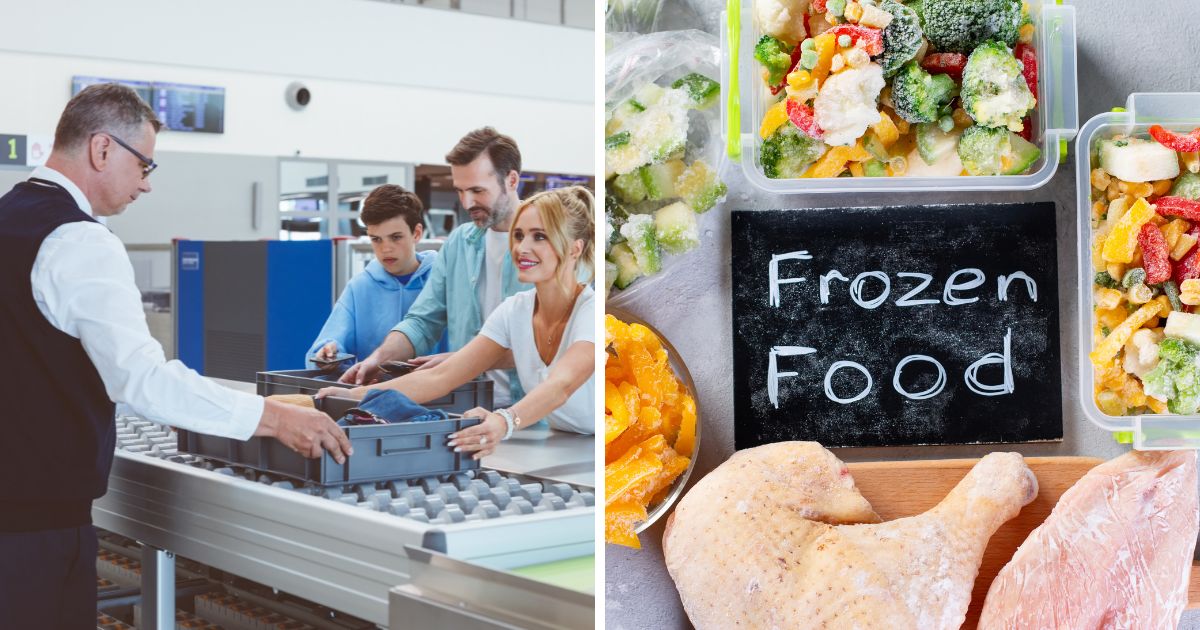Travelers often face confusion when carrying food on flights. The Transportation Security Administration (TSA) has firm rules for liquids, but the good news is that many different food items are permitted on a plane.
Items such as hard cheese, frozen seafood, or even fresh eggs are acceptable in carry-on luggage under TSA guidelines. However, the details can be tricky, and it is important to pack smartly to avoid having items confiscated at the airport.
Packing a frozen meal? If you’re a hungry man or woman and want to have a banquet on your next flight, frozen foods are good to go. You’ve decided to pack the microwave as well? Be sure to check with your airline for their rules on size and weight. pic.twitter.com/3vSCMY420X
— TSA (@TSA) September 10, 2025
As mentioned on the TSA website, “Meat, seafood, vegetables and other non-liquid food items are permitted in both carry-on and checked bags. If the food is packed with ice or ice packs in a cooler or other container, the ice or ice packs must be completely frozen when brought through screening. If the ice or ice packs are partially melted and have any liquid at the bottom of the container, they will not be permitted.”
When considering what one can fly with, the biggest restriction is for anything that falls into the liquid or creamy category. TSA’s well-known 3-1-1 rule applies here: liquids, gels, and aerosols must be in containers of 3.4 ounces (100 milliliters) or less, all fitting in one quart-size bag, with only one bag allowed per passenger.
Popular food items such as peanut butter, salsa, or olive oil fall into this category. If they are larger than the permitted size, they will need to be checked or shipped home.
There is also a judgment factor to consider. TSA has an official food list available on its website, but the final decision often lies with the security agent one meets in line. Because of that, it is smart to pack food neatly and clearly to help avoid misunderstandings.
Some types of food are much easier to carry. For example, vacuum-sealed meats and hard cheeses are considered non-liquid and can safely travel in either carry-on or checked baggage.
To make the process smoother, it is wise to keep them sealed tightly in their original packaging. Many shops provide pre-sealed products, and in some cases, they may help with vacuum-sealing items for travel shoppers.
Cheese lovers should remember that creamy varieties are considered liquid-like under TSA rules. These can only be transported in quantities under 3.4 ounces if kept in a carry-on bag. Anything larger must be placed in checked luggage.
Spices happen to be another food related item that rarely pose a problem for air travel. Since they are dry items, TSA allows them in both carry-on and checked baggage. To avoid confusion, it is best to keep spices unopened, labeled, and neatly packed.
For those with a sweet tooth, hard candy and chocolate make excellent travel companions. TSA has no restrictions on solid confectionery, so one can carry them in their luggage without concern. However, it should be kept in mind that those items should be in their original packaging and packed neatly to prevent damage during transit.
View this post on Instagram
For parents traveling with infants, special allowances apply to baby food, formula, juice, and even water for babies. These items may exceed the usual liquid limit but will be subject to additional screening at security. They are also fine when packed in checked luggage.
Alcohol presents another set of restrictions. A traveler should be cautious when carrying strong liquors. TSA prohibits any alcohol over 70 percent alcohol content (140 proof) from both carry-on and checked baggage.
Examples include Everclear, grain alcohol, and some high-proof varieties of vodka, whisky, rum, or absinthe. Lower-proof alcohols are allowed within standard limits, but stronger spirits must be avoided.
View this post on Instagram
Canned goods, while technically permissible, are a common source of complication. Because most cans are larger than 3.4 ounces, they often cannot be carried through security in hand luggage. They can be packed into checked bags, but shipping them separately is often more practical to save trouble during screening.
When uncertain, the best solution is to pack food in checked baggage or arrange shipping. This ensures smooth traveling while also avoiding long queues at the check-in line. Moreover, careful packing and knowledge of TSA’s food rules can keep one’s air journey stress-free.













